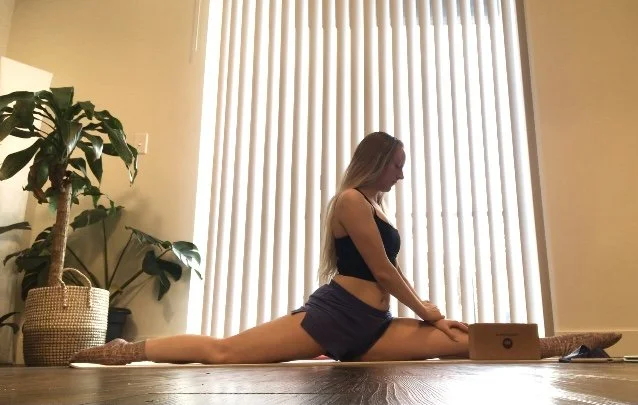(Some of) The Science of Stretching
Do you have big flexibility goals? Read on for some tips on how to improve your stretching routine!
Stretching the Splits
What is stretching?
When we stretch, we are moving the origin and insertion points of a muscle away from each other. You can think of stretching a muscle like stretching a rubber band or hair-tie – we are creating tension by pulling two end points away from each other.
What are the types of stretching?
While there are more categories than this, for today’s discussion we will talk about stretching as either static or dynamic. Static stretching is when you are in a stretch and don’t change the position for an extended period of time. Dynamic stretching is when you move through a range of motion while you’re in a stretch.
Static stretching is excellent for cool-downs after a dance or fitness class because it can help you to slow down your heart rate, regulate your nervous system, and may help prevent DOMS (delayed onset muscle soreness). Additionally, since you are warm after class, you may find that you are able to achieve greater range of motion in your stretches. The ideal time to do extended static stretching is when muscles are already warm for safety and for increasing flexibility over time.
Dynamic stretching, on the other hand, is great for warming up before a dance or fitness class. Dynamic stretching helps to increase blood flow, lubricate the joints, and encourage the nervous system to shift into “go-mode” to prepare for the demands of class. You’ll find that our classes that may require a bigger range of motion (such as ballet) will include dynamic stretches in the warm-up – this is to help make sure you will be ready for those big moves during class!
Stretching at the Ballet Barre
How long should I stretch for?
For dynamic stretches, a good rule of thumb is to switch between positions every 10 seconds or less. For static stretches, research has shown that anywhere from 30 seconds to several minutes can create lasting flexibility changes. If you’re new to stretching, try holding your static stretches for 30 seconds, and then increase from there! Most people will need to increase their stretching hold time as they progress in order to see continued flexibility gains.
How often do I need to stretch?
In flexibility, as in fitness in general, the name of the game is consistency, not intensity. That means you’ll probably see better results from doing shorter stretching sessions several times per week, versus a really long stretching session only once per week.
It’s kind of like how we need to brush our teeth a little bit every day, instead of 20 minutes once a week. Your muscles need the reminder of the range of motion you want them to be able to achieve, and they need the reminder often. Try stretching for 10-15 minutes after every class or workout. If you’re taking class 3 days per week, that’s 30-45 minutes of stretching per week! You’ll definitely see progress with that kind of consistency.
Seated Forward Fold Stretch
What are some other tips to work on my flexibility?
Some other things that you can do to improve your flexibility are to foam roll, stay hydrated, and to focus on slow, intentional breathing while you stretch. We’ll try to talk more in-depth about these topics in future blog posts!
In the meantime, if you want help working on your flexibility routine, join us for our Yoga for Flexibility classes here at White Mountain Dance Studio in Pinetop, AZ. These yoga classes use dynamic stretches in the warmup, and then focus on static stretches the rest of class (in the style of Yin Yoga) to help you make real progress in your flexibility. Plus, you’ll get all the other benefits of a yoga practice, like reduced stress, improved sleep, better mobility, and so much more!
Head over to https://whitemountaindancestudio.punchpass.com/classes to save your spot in a yoga class! We can’t wait to stretch with you 😊🧘
-Skylar


